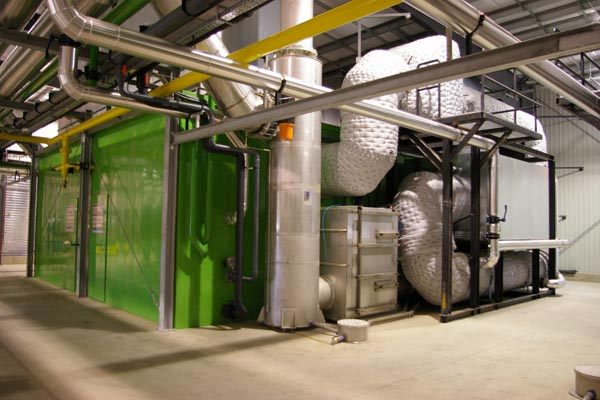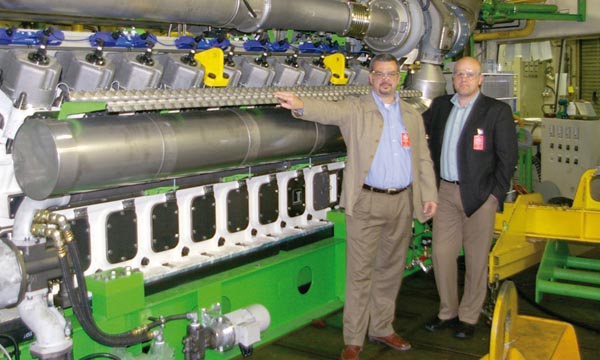Skyrocketing energy prices were eating up an ever-growing share of Soave Hydroponics Company’s production costs. But for the parent company of Great Northern Hydroponics, a 55-acre greenhouse tomato operation in Kingsville, Ontario, a short-term solution wouldn’t do. Both its president and general manager want the business to thrive for the next 20 years – perhaps even the next 100 – and help, rather than hurt, the environment.

“It’s a win-win situation,” crowed the cover story in Greenhouse Canada’s June 2008 edition. “The province gets a clean and reliable electricity source, while Soave Hydroponics (which is owned by Detroit, Michigan-based Soave Enterprises) gets the heat and CO2, along with the ability to buy electricity minus the usual transportation costs.”
 The 12 MW cogeneration system features four Jenbacher JMS 620 gas engines as well as heat recovery and exhaust treatment equipment, noise abatement and systems controls. The cogeneration plant operates with a system efficiency better than 93% and will provide enough electricity to the Ontario grid to power 8,000 to 12,000 Canadian homes. Power produced by the plant will be sold under a 20-year contract with the Ontario Power Authority.
The 12 MW cogeneration system features four Jenbacher JMS 620 gas engines as well as heat recovery and exhaust treatment equipment, noise abatement and systems controls. The cogeneration plant operates with a system efficiency better than 93% and will provide enough electricity to the Ontario grid to power 8,000 to 12,000 Canadian homes. Power produced by the plant will be sold under a 20-year contract with the Ontario Power Authority.
How it all came about
Soave began looking at ways to deal with the rising cost of fossil fuels about four years ago and soon realized that a cogeneration system could help address the high cost of energy while also helping the environment. Already proven in Europe – the Jenbacher system can be found in more than 500 greenhouses to date – the natural gas-based system generates electricity, while the engine exhaust can be purified, cooled and pumped back into the greenhouse, allowing the plants to benefit from the CO2 present in the exhaust. After touring similar installations in Holland, Soave President Darrin Didychuk was even more convinced, and when the Ontario Power Authority issued a Request for Proposals to add 1,000 MW of cogeneration power to the local grid, Soave assembled a team of companies, including DDACE and GE, to submit a proposal. Soave was the first greenhouse – of about 20 that DDACE had approached – to submit a proposal in response to the RFP.
Support from the Netherlands
The technology involved can appear intricate.
“There is a complex technology interface with the greenhouse that needs to be recognized and understood,” said Jan Buijk, Vice President and General Manager of DDACE.
“Engaging the Jenbacher Center of Excellence to determine how to integrate the cogeneration system in the greenhouse is critical,” explains Dick Kramp, marketing program manager for Jenbacher greenhouse applications. “To ensure success of this project, our distributor built on the expertise that has been developed in the Netherlands and offered complete, fully integrated systems to the greenhouse owners. We have to think beyond our battery limits to be sure that the concept is installed in the best possible infrastructure to avoid technical issues during and after commissioning.”
Construction on the project began in May 2007 and was completed about a year later. The US$20 million project includes continued support from DDACE, which sent two of its service technicians to the Netherlands for four weeks of greenhouse-specific training. In addition, the COE helpdesk in the Netherlands remotely monitors the entire cogeneration plant and continues to provide DDACE with expertise, if needed.
“It’s one thing to build a sound cogeneration plant,” Jan Buijk said. “It’s even more important to make sure it is running successfully for the next 20 years.”
Win-Win Solution
With the startup in May 2008 of the cogeneration system, Soave is able to reduce its energy costs and generate additional revenues without curtailing its annual production levels, thus improving its competitive position in the commercial tomato industry.
And the system itself “has the North American industry talking,” Greenhouse Canada claimed. A variety of engineers and greenhouse representatives have toured the facility, according to Soave’s Didychuk. “This is one of the best installations I’ve seen, and everyone who tours it is very impressed with its efficiencies.”
— Adapted from an article originally published in CoJen, a publication of Jenbacher.
